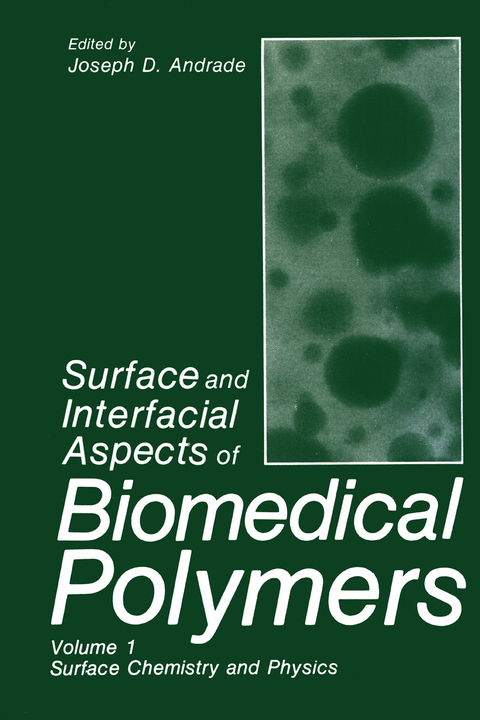
Surface and Interfacial Aspects of Biomedical Polymers
Springer-Verlag New York Inc.
978-1-4684-8612-4 (ISBN)
This book is intended to provide a fundamental basis for the study of the interaction of polymers with living systems, biochemicals, and with aqueous solutions. The surface chemistry and physics of polymeric materials is a subject not normally covered to any significant extent in classical surface chemistry textbooks. Many of the assumptions of classical surface chemistry are invalid when applied to polymer surfaces. Surface properties of polymers are important in the development of medical devices and diagnostic products. Surface properties are also of vital importance in fields such as adhesion, paints and coatings, polymer-filler interactions, heterogeneous catalysis, composites, and polymers for energy generation. The book begins with a chapter considering the current sources of information on polymer surface chemistry and physics. It moves on to consider the question of the dynamics of polymer surfaces and the implica tions of polymer surface dynamics on all subsequent characterization and interfacial studies. Two chapters are directed toward the question of model polymers for preparing model surfaces and interfaces. Complete treatments of X-ray photoelectron spectroscopy and attenuated total reflection infrared spectroscopy are given. There is a detailed treatment of the contact angle with particular emphasis on contact angle hysteresis in aqueous systems, followed by chapters on interfacial electrochemistry and interface acid-base charge-transfer properties. The very difficult problem of block and graft copolymer surfaces is also discussed. The problem of theoretical calculations of surface and interfacial tensions is presented. Raman spectroscopy is considered as an analytical technique for polymer surface characterization.
1. Introduction to Surface Chemistry and Physics of Polymers.- 1. Sources.- 2. Objectives.- 3. Overview.- 4. Limitations.- 5. References.- 2. Polymer Surface Dynamics.- 1. Introduction.- 2. Polymer Transitions and Relaxations.- 3. Probing Polymer Motions and Transitions.- 4. Polymer Surface Motions.- 5. Conclusions.- 6. Summary.- Acknowledgments.- References.- 3. Model Polymers for Probing Surface and Interfacial Phenomena.- 1. Introduction.- 2. Stereoregular Polymers.- 3. Hydroxyethyl Methacrylate Copolymers.- 4. Block Copolymers.- 5. Alkyl Methacrylates.- 6. Derivatized Agarose.- 7. Polyurethanes.- 8. Poly(?-Amino Acids).- 9. Summary/Conclusions.- Acknowledgments.- References.- 4. Polymeric Oriented Monolayers and Multilayers as Model Surfaces.- 1. Introduction.- 2. Polymerized Model Membranes.- 3. Conclusions.- References.- 5. X-ray Photoelectron Spectroscopy (XPS).- 1. Introduction.- 2. Basic Principles of XPS.- 3. Elemental Analysis.- 4. Chemical Bonding.- 5. Functional Group Labelling.- 6. Data Processing.- 7. Variable Angle Methods.- Acknowledgments.- References.- 6. Surface Infrared Spectroscopy.- 1. Introduction.- 2. Infrared Spectroscopy.- 3. Principles of Internal Reflection.- 4. Polymer Applications of Total Internal Reflection Infrared Spectroscopy.- 5. Summary.- Acknowledgment.- References.- 7. The Contact Angle and Interface Energetics.- 1. Introduction.- 2. Fundamentals.- 3. Contact Angle Measurement.- 4. Contact Angle Hysteresis.- 5. Interfacial Energetics.- 6. Charge Effects.- 7. Conclusions.- Acknowledgments.- References.- 8. Interfacial Electrochemistry of Surfaces with Biomedical Relevance.- 1. Introduction.- 2. Basic Electrical Parameters.- 3. Double Layer Models.- 4. Double Layer Theory.- 5. Interpretation of Electrokinetic Potentials.- 6.Experimental.- 7. Conclusions.- References.- 9. Interface Acid-Base/Charge-Transfer Properties.- 1. The Acid-Base Character of “Polar” Interactions.- 2. The Surface Acidity or Basicity of Polymers.- 3. The Surface Acidity or Basicity of Inorganic Surfaces.- 4. Charge Transfer between Phases.- Acknowledgment.- References.- 10. Graft Copolymer and Block Copolymer Surfaces.- 1. Introduction.- 2. Graft Copolymer Surfaces.- 3. Block Copolymer Surfaces.- 4. Segmented Polyurethanes.- Acknowledgments.- References.- 11. Interfacial Tensions at Amorphous Polymer-Water Interfaces: Theory.- 1. Introduction.- 2. The Theory of Surface and Interfacial Tensions of Amorphous High Polymers.- 3. The Theory of Interfacial Tension at Polymer-Water Interfaces.- References.- 12. Surface Raman Spectroscopy.- 1. Introduction.- 2. Raman Scattering Effect.- 3. Surface and Thin Film Raman Spectroscopy.- 4. Instrumental Improvements.- 5. Conclusion.- Acknowledgments.- References.- 13. Polymer Surface Analysis: Conclusions and Expectations.- 1. Introduction.- 2. Microscopy.- 3. Expectations.- 4. Conclusions.- References.
| Zusatzinfo | 486 p. |
|---|---|
| Verlagsort | New York, NY |
| Sprache | englisch |
| Maße | 152 x 229 mm |
| Themenwelt | Sachbuch/Ratgeber ► Natur / Technik ► Garten |
| Naturwissenschaften ► Chemie ► Anorganische Chemie | |
| Naturwissenschaften ► Chemie ► Organische Chemie | |
| Naturwissenschaften ► Chemie ► Physikalische Chemie | |
| Technik ► Maschinenbau | |
| ISBN-10 | 1-4684-8612-8 / 1468486128 |
| ISBN-13 | 978-1-4684-8612-4 / 9781468486124 |
| Zustand | Neuware |
| Haben Sie eine Frage zum Produkt? |
aus dem Bereich


